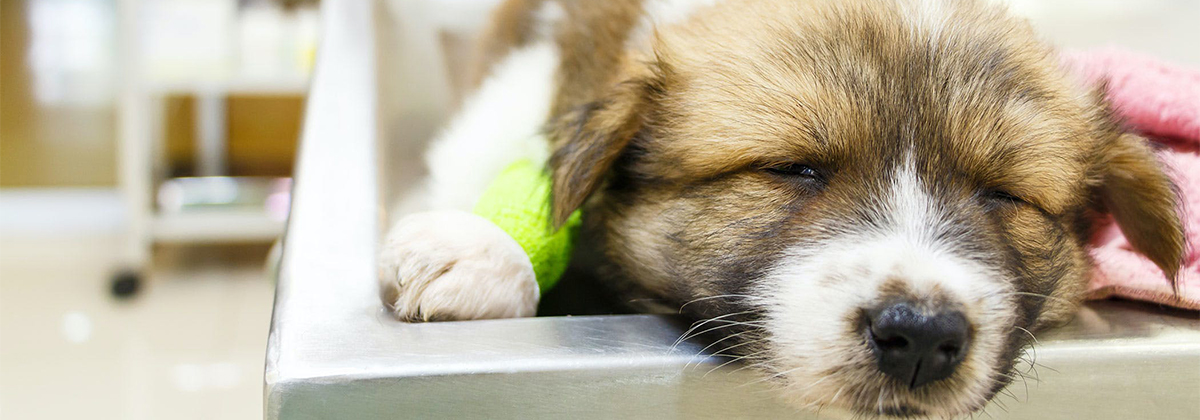05 Apr Parvo in Dogs: Causes, Symptoms, & Treatment
Parvo is the worst nightmare and disease for puppy and dog owners. Within a few days, the disease can make a perfectly healthy and playful puppy sick and weak. Fortunately, this disease is preventable. Therefore, all puppy owners and those in contact with these lovely creatures should be aware of parvo’s dangers and how to prevent and treat them.
Definition of parvo in dogs
Parvo is a highly contagious and deadly virus that causes an infectious disease of the gastrointestinal tract in puppies and young dogs. The most dangerous part of this disease is its ease and speed of spread among dogs. The virus is spread through direct contact with infected dogs, faeces and spreads to other dogs four to five days later before the dog shows clinical signs of infection. The sick dog is infected with the virus for up to 10 days after recovery. For your dog’s health, his disease must be accurately diagnosed and separated from the rest of the dogs and quarantined.
Dogs at risk of parvo
Young dogs between six weeks and six months, unvaccinated dogs, and breeds such as German Shepherd, Rottweiler, Doberman Pinscher, English Springer Spaniel, and American Staffordshire Terriers are more susceptible to parvo. It isn’t clear to scientists why these breeds are endangered.
Puppies are born with their mothers’ antibodies, which fade over time. Stress from weaning and secondary parasites or infection with the parvovirus can make the disease worse. This is why it is essential to talk to your veterinarian about caring for puppies and pregnant dogs.
Causes
Parvovirus can be transmitted in dogs in two ways. The first is through direct contact of the nose and mouth with the infected faeces, which may occur if your dog inhales or lick an infected surface or another dog. Puppies discover their world through sniffing and licking, so you can easily understand why and how your curious puppy became infected with this virus.
The second method of transmission is through indirect puppy contact with an infected person, object or environment. The virus can survive on clothing, equipment, human skin and the environment, too.
Parvovirus is very resistant and robust in dogs. The virus can live for at least two months indoors, and at room temperature, it’s also resistant to many common cleaners and disinfectants. Even outdoors, parvo can survive for months or even years if protected from direct sunlight. That is why the infected dog’s quarantine and proper environmental cleaning is critical in controlling this disease.
Faeces-contaminated shoes can also introduce the virus into the dog’s environment. So you have to be very careful because parvo can live on the ground for up to a year. To prevent this problem, you should wash the contaminated area with household bleach; Bleach is a few disinfectants used to kill the virus.
When a dog becomes infected with parvo, the virus multiplies in the small intestine, lymph tissue (lymph nodes, thymus, etc.) and bone marrow. This leads to severe gastrointestinal problems and myocarditis (inflammation of the heart).
symptoms
The most common symptoms of parvovirus in dogs are:
- Severe diarrhoea and blood
- Lethargy
- Anorexia
- Fever
- Vomit
- Weight Loss
- Weakness
- Depression
- Dehydration
Contact your veterinarian immediately if you notice any or all of these symptoms in your dog. Even if the cause of these symptoms isn’t parvovirus, there may be another disease in your dog that needs veterinary attention.
Parvo treatment in dogs
If your dog has a parvo, take him to a veterinarian immediately for treatment. Parvo is a deadly virus that needs special care; So the sooner your dog is diagnosed with the disease, the better for his health. Your veterinarian will probably hospitalise your dog and quarantine him to better care and control secondary infections.
Depending on the severity of the disease, your veterinarian may prescribe a range of medications, such as antibiotics, to prevent bacterial infections from entering the dog through the damaged intestinal wall. In severe cases, parvo reduces your dog’s ability to fight infection by reducing the number of white blood cells. Therefore, the veterinarian gives your dog fluids, nutrition and various medicines to save his life, which is why it’s vital to take the dog to the veterinarian.
Most puppies that survive the first 3 to 4 days recover entirely after about a week. Your veterinarian will guide you through the recovery process and adjust the program to suit your puppy’s needs.
Parvo prevention in dogs
Parvo is entirely preventable in dogs. This vaccine is required for all breeds but even vaccinated dogs aren’t entirely protected against the virus. The parvovirus vaccine is usually given three times; When the puppy is between 6 to 8 weeks, 10 to 12 weeks and 14 to 16 weeks. The booster injection is done one year later and every three years.
Unvaccinated puppies shouldn’t be exposed to other dogs or in an environment contaminated with the parvovirus. Therefore, please don’t take your dog to different places until fully vaccinated and in good health.
Unvaccinated puppies quickly interact with fully vaccinated adult dogs in safe environments such as at home. This socialisation is perfect for your dog’s growth and mental health. But most puppy classes require vaccination proof to register. Therefore, vaccination is necessary before participating in group gathering and classes. Puppies should never be in places such as daycare or training classes until they are fully vaccinated at 14 to 16 weeks old.
Familiarity with the parvovirus in dogs is essential to prevent the spread of this dangerous virus and its treatment. That’s why you should keep your puppy vaccinated at the right age and your unvaccinated puppies in a safe environment. Contact your veterinarian immediately if you feel that your dog is infected with this disease. Mishka specialised group will accompany you in the path of your dog training, maintenance and grooming.




No Comments